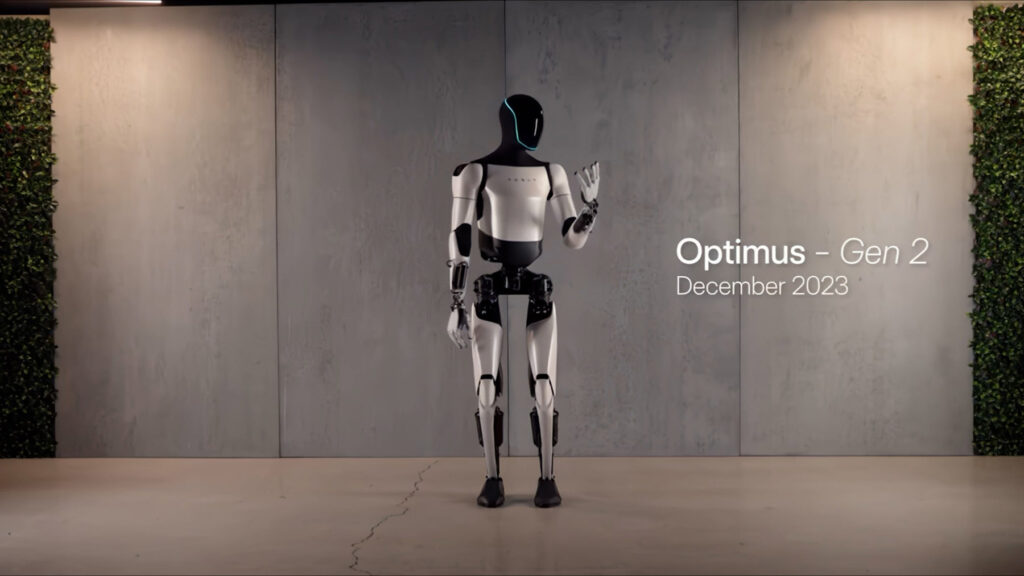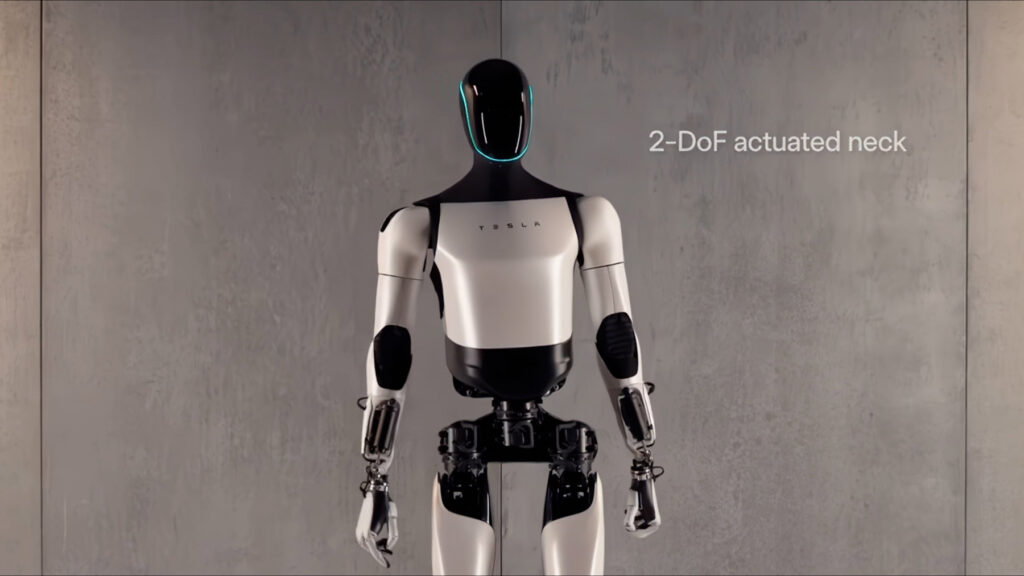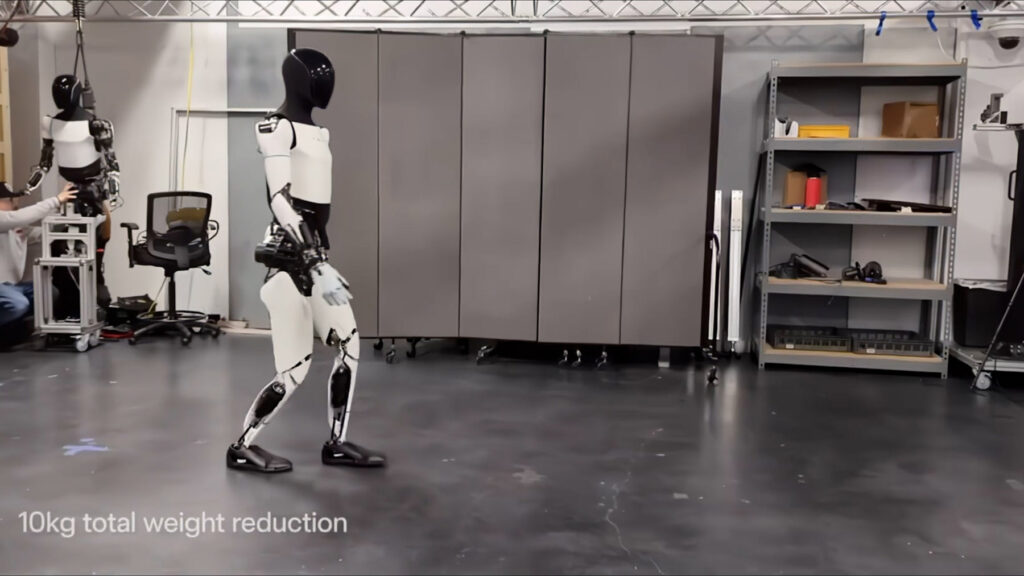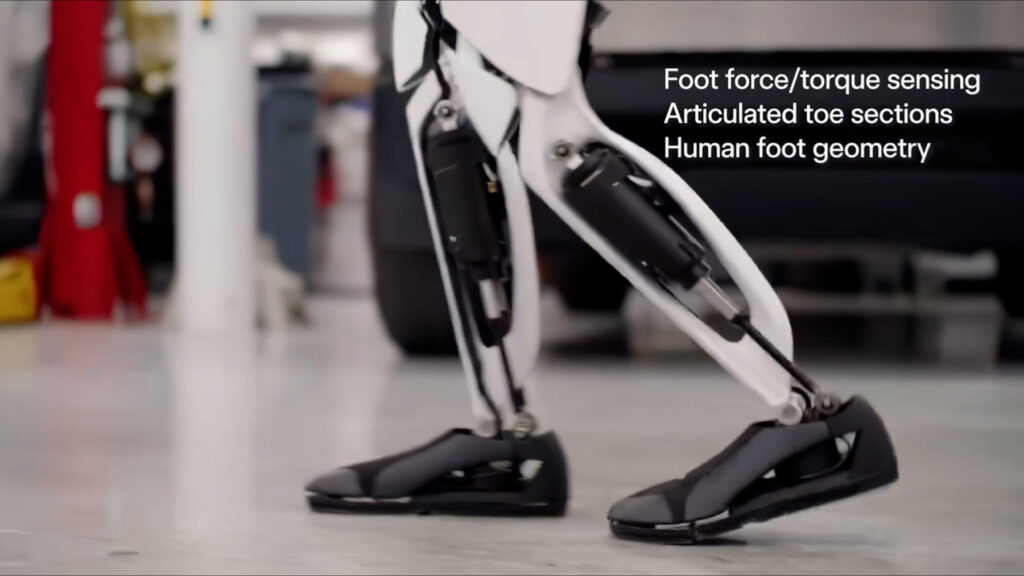This afternoon Tesla released the latest video of their Optimus humanoid robot. The updated version is labelled as Optimus – Gen 2 and features a number of improvements in design and functionality.
Straight away you’ll notice a pretty significant change to the way Optimus looks. The head is now fully formed with a coloured LED around the edges of where a human’s face would be. It’s not clear what this will be used for, but could communicate to the humans around if the robot is actively completing a task, returning to charge, charging, or even off.
While we don’t see an illuminated face on Optimus, that doesn’t mean we won’t be the time it hits production. The chassis of the robot has been updated a lot since the version we saw in May. Previously we saw Optimus with exposed legs and a pretty elementary implementation of an exterior protecting the electronics inside its chest and forming an early version of the human form.
Optimus is now looking much more like a commercial product with the white exterior body panels, atop a black chassis underneath. The black/white combination works well as a clean, modern design aesthetic.

The next title in the video reads ‘2-DoF actuated neck’. Previously Tesla had made the neck rigid, not something that was a focus, but clearly in gen2, Teslabot is getting multiple new ranges of motion to better reflect what humans are capable of, important when attempting to replicate many work tasks done by humans.
Having 2 degrees of freedom (up/down and left/right) in an articulated neck should mean Optimus can look around and see objects like a body between his feet. Given the whole robot leverages computer vision, it is critical to ensure the cameras in the head can look in every direction to safely and competently complete tasks.


As we see more of the video, it becomes obvious that there’s been a significant design tweak to the arms. While the original concept showed the humanoid robot featuring quite slender forearms, Tesla has gone with a dual-actuator design to rotate the wrist (with strength).
At least for now, these Tesla-designed actuators don’t fit inside the confines of a human arm that thins towards the hands, instead, they opted to use cut outs to allow them to protrude out each side of the arm.


Teslabot has gone on somewhat of a diet, with Gen 2 now a whole 10kg lighter than the last generation. Reducing weight should increase battery life, as it requires less energy to move the robot.


Not only did Teslabot lose weight, it also got faster, Optimus Gen2 got a 30% walk speed boost. Being able to walk faster will translate into the bot being able to complete work tasks that require moving, much faster than first thought.
The walking motion still isn’t what I’d describe as human-like, although with a very different weight distribution, I’m not sure if that’s technically possible. It’s likely not super important that the bot replicates our walking motion exactly, but rather it can move from A-to-B swiftly and safely, while also transporting a payload.


Teslabot Gen 2 offers improved balance and full-body control. To demonstrate this, Teslabot is shown in the gym, performing squats which isn’t particularly useful in a workload capacity but may be an indication that its capable of moving through awkward environments.


The changes to the Optimus feet in Gen 2 are perhaps the most significant update. No longer does Optus have a flat duck foot, but rather now an advanced foot that features foot force/torque sensing along with an articulated toe section.
This articulation, or bend in the foot, should allow Optimus much better capability in walking, as well as better stability when walking up and down stairs.
Tesla also highlights the human foot geometry, which could be important if you want to dress the robot in protective footwear.
In this shot we also see the same approach to hiding the actuator inside the limb, with the lower leg open, supporting a large actuator inside. We’re going to assume that all of this is sealed from the weather to support outdoor use cases.


It is clear, Tesla engineers have focused a lot on the hands with the second generation. They are now brand new hands, showing almost a complete rethink of how they approach the hands.
Teslabot’s hands are now faster, allowing faster movement accelerate tasks. We can see in parts of the video, that the bot folds each finger and moves the thumb left and right as well as open and closed. In total, the hands now feature 11 degrees of freedom.






With all new hands, comes new abilities. Teslabot Gen 2 can now manipulate delicate objects. While we’ve been impressed with Teslabot’s ability to manipulate cubes in a tray, Teslabot can now pick up an egg without crushing it, or dropping it.
Having amazing dexterity in the fingers and fingertips significantly broadens the applications for Teslabot. Seeing the bot interact with an egg shows that the robot could easily be applied to cooking applications, while also being suitable for work in a factory.
This raises the biggest question, as impressive as what we’ve seen in the new video today, is Teslabot currently deployed in any production workloads at Tesla, in their factories or otherwise?
The video ends with the title ‘Stay tuned to see what Optimus will do next’. This is followed by a couple of Gen 2 Teslabots dancing which is really designed to showcase the speed and range of movement available.




You can watch the new Tesla Optimus Gen 2 video here.

Not even one shot of it carrying a load, so who knows how stable it is. And people think that this, powered by the same AI that has not even been deployed in a Boring tunnel, the most complementary environment for FSD, is going to be available anytime soon?
It’s not happening folks. Not for a long while.
Agree with you Scott, carrying loads would have been something great to see at this stage of development. I’m confident it will, but for now, we wait..